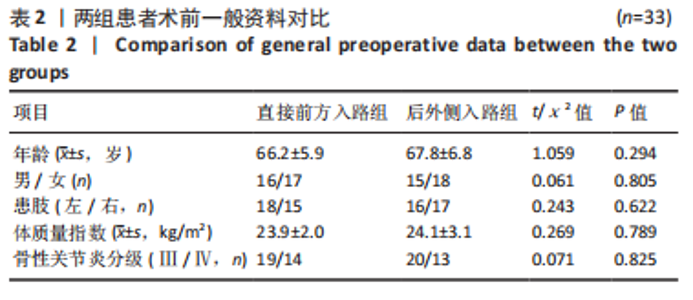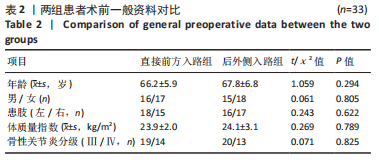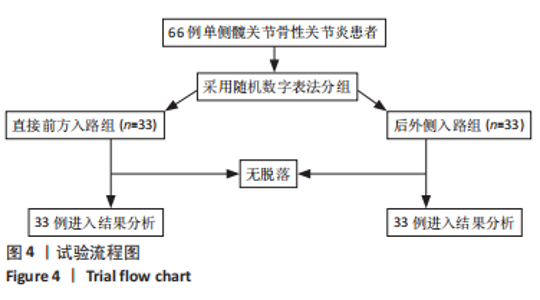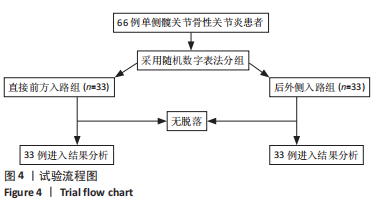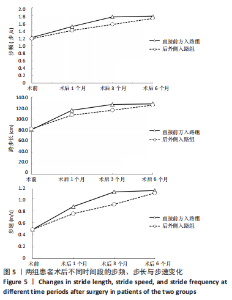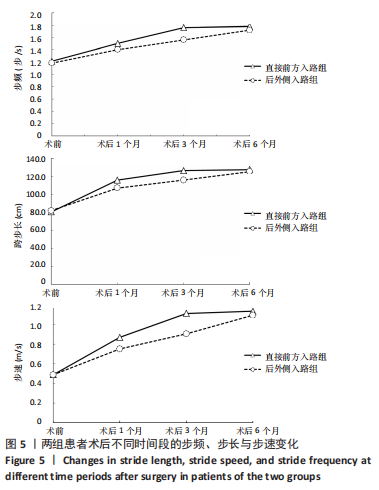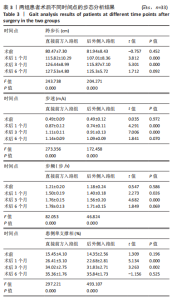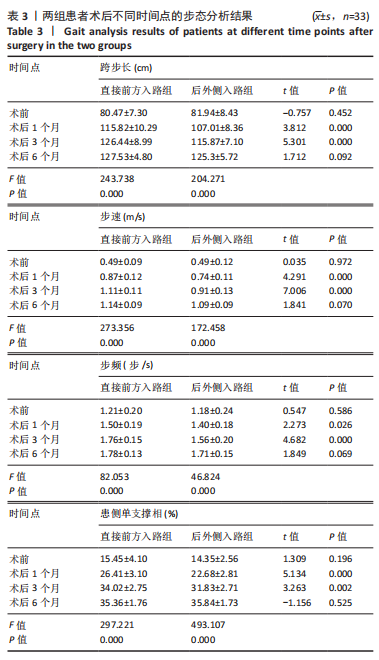[1] AKYOL Y, DURMUS D, ALAYLI G, et al. Does short-wave diathermy increase the effectiveness of isokinetic exercise on pain, function, knee muscle strength, quality of life, and depression in the patients with knee osteoarthritis? A randomized controlled clinical study. Eur J Phys Rehabil Med. 2010;46(3): 325-336.
[2] 夏冬雪,陈广滨,李敏.全髋与半髋关节置换术治疗老年股骨颈骨折的疗效对比[J].中国实用医药,2021,16(8):83-85
[3] MURPHY LB, CISTERNAS MG, PASTA DJ, et al. Medical Expenditures and Earnings Losses Among US Adults With Arthritis in 2013. Arthritis Care Res (Hoboken). 2018;70(6):869-876.
[4] RIES MD. Relationship Between Functional Anatomy of the Hip and Surgical Approaches in Total Hip Arthroplasty. Orthopedics. 2019;42(4):e356-e363.
[5] 郭团茂,行艳丽,朱海云,等.直接前入路全髋关节置换术治疗大骨节病性髋关节炎的临床效果[J].临床医学研究与实践,2021,6(2):39-41.
[6] MJAALAND KE, KIVLE K, SVENNINGSEN S, et al. Do Postoperative Results Differ in a Randomized Trial Between a Direct Anterior and a Direct Lateral Approach in THA. Clin Orthop Relat Res. 2019;477(1):145-155.
[7] ALECCI V, VALENTE M, CRUCIL M, et al. Comparison of primary total hip replacements performed with a direct anterior approach versus the standard lateral approach: perioperative findings. Orthop Traumatol. 2011;12(3):123-129
[8] ILCHMANN T, GERSBACH S, ZWICKY L, et al.Standard transgluteal versus minimal invasive anterior approach in hip arthroplasty: a prospective, consecutive cohort study. Orthop Rev(Pavia). 2013;5(4):e31.
[9] Yue C, Kang P, Pei F. Comparison of direct anterior and lateral approaches in total hip arthroplasty: a systematic review and metaanalysis (PRISMA). Medicine (Baltimore). 2015;94(50):e2126.
[10] LUGADE V, WU A, JEWETT B, et al. Gait asymmetry following an anterior and anterolateral approach to total hip arthroplasty. Clin Biomech (Bristol, Avon). 2010;25(7):675-680.
[11] CICHY B, WILK M. Gait analysis in osteoarthritis of the hip[J]. Med Sci Monit 2006;12(12):R507-R513.
[12] 韩兵,缪霆.髋关节骨性关节炎对步态参数的影响[J].实用医药杂志,2015, 32(7):623.
[13] 卢斌,徐立岩,柏豪豪,等.步态分析在髋关节骨性关节炎患者中应用的研究概况[J].中国中西医结合外科杂志,2020,26(4):794-798.
[14] CALLISAYA ML, BLIZZARD L, SCHMIDT MD, et al. Ageing and gait variability–a population-based study of older people. Age Ageing. 2010;39(2):191-197.
[15] YOO J, CHA YH, KIM KJ, et al. Gait analysis after total hip arthroplasty using direct anterior approach versus anterolateral approach: a systematic review and meta-analysis.BMC Musculoskelet Disord. 2019;20(1):63.
[16] 张驰,吕浩源,章晓云,等.不同入路全髋关节置换后髋关节功能的网状Meta分析[J].中国组织工程研究,2019,23(8):1248-1257.
[17] TEMPORITI F, ZANOTTI G, FURONE R, et al. Gait analysis in patients after bilateral versus unilateral total hip arthroplasty. Gait Posture. 2019;72:46-50.
[18] STOCKHAUSEN KE, RIEDEL C, BELINSKI AV, et al. Variability in stem taper surface topography affects the degree of corrosion and fretting in total hip arthroplasty. Sci Rep. 2021;11(1):9348.
[19] 徐鹏,杨光,强晓军.髋关节骨性关节炎患者髋臼唇的组织学变化[J].中国骨与关节损伤杂志,2021,36(2):145-147.
[20] 张昊华,闫松华,方沉,等.用便携式步态分析仪评估全髋关节置换术手术效果[J].医用生物力学,2015,30(4):361-366.
[21] BOVONSUNTHONCHAI S, THONG-ON S, VACHALATHITI R, et al. Alteration of the multi-segment foot motion during gait in individuals with plantar fasciitis: a matched case-control study. Acta Bioeng Biomech. 2019;21(4):73-82.
[22] JOHNSON VL, HUNTER DJ. The epidemiology of osteoarthritis. Best Pract Res Clin Rheumatol. 2014;28(1):5-15.
[23] 王浩洋,康鹏德,聂涌,等.直接前入路全髋关节置换后早期三维步态分析[J].北京大学学报(医学版),2017,49(2):196-200.
[24] RATHOD PA, ORISHIMO KF, KREMENIC IJ, et al.Similar improvement in gait parameters following direct anterior & posterior approach total hip arthroplasty. J Arthroplasty. 2014;29(6):1261-1264.
[25] MENEGHINI RM, SMITS SA, SWINFORD RR, et al. A randomized, prospective study of 3 minimally invasive surgical approaches in total hip arthroplasty: comprehensive gait analysis. J Arthroplasty. 2008;23(6 Suppl 1): 68-73.
[26] QUEEN RM, APPLETON JS, BUTLER RJ, et al.Total hip arthroplasty surgical approach does not alter postoperative gait mechanics one year after surgery. PM R. 2014;6(3):221-226.
[27] 邓苏爱,郭雨露,周文静,等.肌肉损伤与修复的研究进展[J].武汉轻工大学学报,2020,39(2):27-34.
[28] ZHAO HY, KANG PD, XIA YY, et al.Comparison of Early Functional Recovery After Total Hip Arthroplasty Using a Direct Anterior or Posterolateral Approach: A Randomized Controlled Trial. J Arthroplasty. 2017;32(11):3421-3428.
[29] WEIDOW J, TRANBERG R, SAARI T, et al. Hip and knee joint rotations differ between patients with medial and lateral knee osteoarthritis: gait analysis of 30 patients and 15 controls. J Orthop Res. 2006;24(9):1890-1899.
[30] 韦宝琛.直接前侧入路与后外侧入路全髋关节置换术的疗效比较[J].临床骨科杂志,2021,24(1):30-33.
[31] AGOSTINI V, GANIO D, FACCHIN K, et al. Gait parameters and muscle activation patterns at 3,6 and 12 months after total hip arthroplasty. J Arthroplasty. 2014;29(6): 1265-1272.
[32] MAFFIULETTI NA, IMPELLIZZERI FM, WIDLER K,e t al. Spatiotemporal parameters of gait after total hip replacement: anterior versus posterior approach. Orthop Clin North Am. 2009;40(3):407-415.
[33] 胡雪艳,恽晓平,郭忠武,等.正常成人步态特征研究[J].中国康复理论与实践,2006,12(10):855-857.
[34] RESTREPO C, PARVIZI J, POUR AE, et al. Prospective randomized study of two surgical approaches for total hip arthroplasty. J Arthroplasty. 2010;25(5):671.
[35] GOEBEL S, STEINERT AF, SCHILLINGER J, et al. Reduced postoperative pain in total hip arthroplasty after minimal-invasive anterior approach. Int Orthop. 2012;36(3):491.
[36] BERGIN PF, DOPPELT JD, KEPHART CJ, et al. Comparison of minimally invasive direct an terior versus posterior total hip arthroplasty based on inflflammation and muscle damage markers. J Bone Joint Surg Am. 2011;93(15):1392.
[37] 张其亮,于瑜,任国清,等.直接前入路与外侧入路全髋关节置换术的早期疗效比较[J].中国骨与关节损伤杂志,2020,35(12):1237-1241.
[38] 陶涛,郭炯炯,徐南伟.微创直接前入路与后外侧入路全髋关节置换术早期疗效的比较[J].中国微创外科杂志,2020,20(5):431-435.
[39] BARRETT WP, TURNER SE, LEOPOLD JP. Prospective randomized study of direct anterior vs postero-lateral approach for total hip arthro-plasty.J Arthroplasty. 2013;28(9):1634-1638. |
